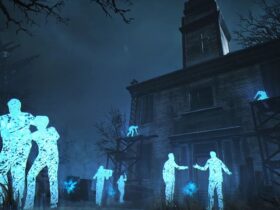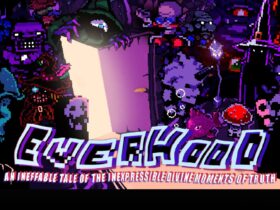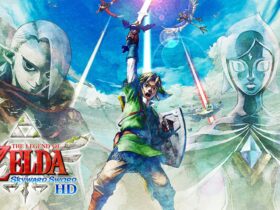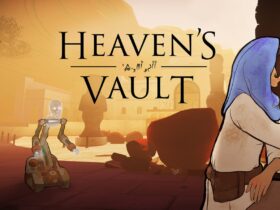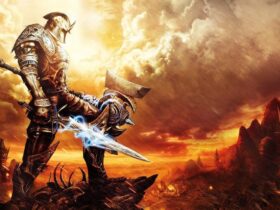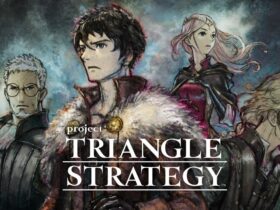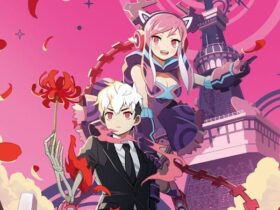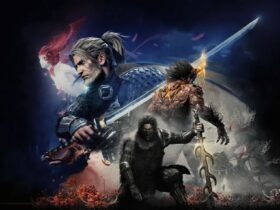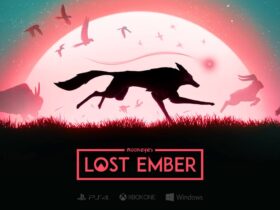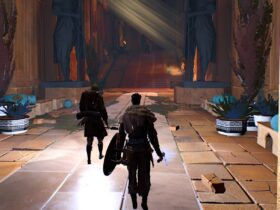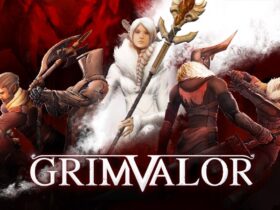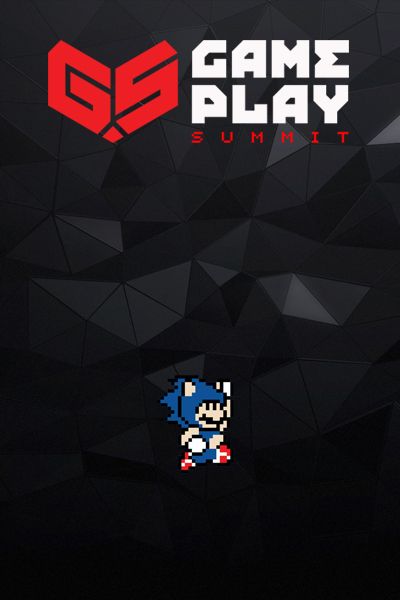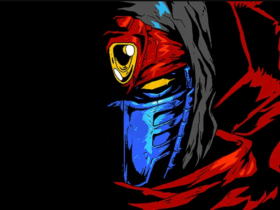Ineffable, indeed.
The beauty of indie games springs from their unrestrained creativity, vision, and innovation. They boldly go where no AAA studio has gone before, free of the yokes of executive meddling, restrained only by the limits of their skill and imagination (and minuscule budgets, of course… but even that’s not always an issue). The results run the gamut from “respectable effort that sadly missed the mark” to “paradigm-shifting masterpiece that’ll leave its mark on gaming for generations to come.”
And then there’s Everhood.
Or, if we go by its full title, Everhood: An Ineffable Tale of the Inexpressible Divine Moments of Truth, which TV Tropes sums up as “Yume Nikki meets OFF meets Undertale (with shades of BitTrip) as a Rhythm Game.” And while that description isn’t wrong, it doesn’t quite capture what makes the game so odd and unique.
Indeed, one only has to look at the title: the word “ineffable,” defined as “incapable of being expressed or described in words; inexpressible,” really says it all. Everhood defies all convention, expectation, and explanation—then turns it all upside down, sideways, and then downside up again (for good measure). It’s a fantastic game, even though it’s hard to articulate why it’s so memorable.
And if I’m honest with myself, this review is about me processing… whatever it was that I just experienced as much as it’s about telling you whether the game’s any good or not. But while my thoughts and feelings on Everhood are just now starting to congeal into coherent sentences, I do know my ~10 hours with it were beautiful, strange, and incredibly profound. Ineffable, indeed.
So, get ready. We’re about to gaze beyond the veil.
Gameplay: The Good, the Bad, and the Frustrating
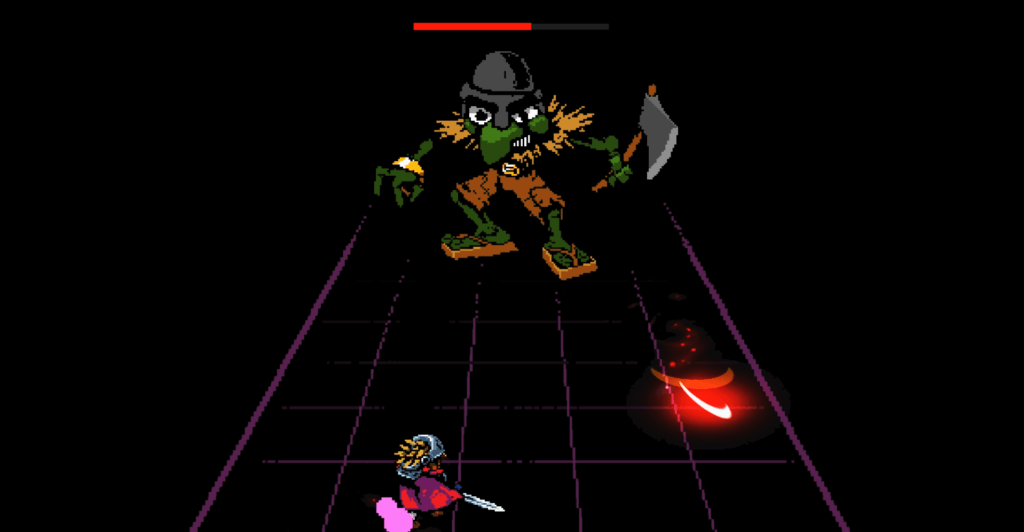
While the game as a whole is challenging to describe, its gameplay is far easier to explain and grasp. As this tweet puts it, Everhood is “Red Geno meets Undertale meets Guitar Hero.” And while that’s putting it too simply, it works well enough as a frame of reference. You know, something familiar to help make sense of something radically different.
Everhood has a few RPG elements, but not enough to (even partially) qualify it as one. Among them: HP meters, an overworld, a limited inventory of one-shot items, a humorous riff on a trading quest, and (in a quite literal sense), as a “game within a game” within the game.
(Don’t worry; it all makes sense in context. Sort of.)
But all of this is incidental. Everhood’s “combat” sequences, where the rhythm mechanics take over, are the game’s main attraction.
Rhythm and Blues (and Reds, and Greens)
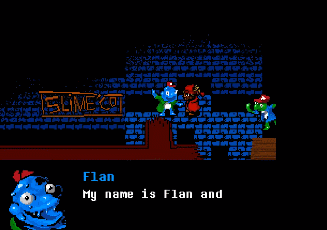
When an encounter starts, you’re whisked away from the overworld and plunked on a five-lane “highway” stretching out towards the horizon, reminiscent of Guitar Hero and its endless spinoffs and imitators. You face your enemy on the other side, dodging the notes they fling towards you to the beat of the music, until either the song ends or (once you’re able to deflect notes) you deplete their HP meter.
If that description, or the phrase “rhythm game” in general, gives you pause, fear not! These rhythm sections are where the game truly comes alive. They’re fun, challenging, multi-sensory extravaganzas where Everhood’s heart and soul spring to life. And I say this as someone who usually passes on rhythm games.
I know these musical “fights” sound strange, different, and counterintuitive (because, to be fair, they are). But from a gameplay perspective, they not only work; they’re practically what make Everhood the game that it is. If they were any less weird or different, this game simply wouldn’t be Everhood.
They’re also hard. Or rather, they can be hard. Fortunately for the rhythmically challenged, the game takes accessibility seriously: you can adjust the difficulty upwards or downwards at any time from its default setting of “Hard.” The gamut runs from “Story Mode” (easiest) all the way up to “Insane” (hardest), and you’ll quickly find the setting that feels right for you. You can even change the difficulty before retrying a battle, for those times “that one boss” starts getting too frustrating.
However, the difficulty level only changes how much HP you lose with each hit, how long you take to recover, and occasionally your enemy’s maximum HP—it doesn’t change the sequence or number of notes, nor the song’s tempo. This means that it’s still easy to lose battles even in story mode, the most accessible difficulty setting, if you’re not paying attention. And fighting the later bosses, especially the brutally unforgiving bonus bosses—even on the more accessible settings—will test your timing, ear-hand-eye coordination, and muscle memory to their limits.
Not a percussionist? You’ll be fine. Can’t hold a beat at all? You’re gonna have a rough time.
Fun Deflecting | Deflecting Fun
So, we have the overworld and the musical “battles.” With these, we can piece together Everhood’s core gameplay loop:
- Wander around the overworld,
- Talk to characters,
- Pick up items and use them once,
- Occasionally encounter a hostile character,
- Engage in musical combat or a mini-game,
- Advance the story,
- Repeat.
It’s a pleasant enough sequence, with more than enough battles (and a couple of clever mini-games) sprinkled in. However, at some point, the game introduces a new mechanic and shakes up the loop. This is where the gameplay gets rough around the edges.
This new mechanic is the ability to deflect notes back at enemies, damaging them. It’s a neat concept, but it feels awkward and out of place. Its introduction also unnecessarily complicates the rhythm battles—which were already near-perfect as they were. They didn’t need any new mechanics.
Now, in addition to merely jumping and rolling to avoid notes, you also need to absorb two consecutive notes of the same color, then shoot them back at your foe—and hope that another note doesn’t suddenly pop up and block your shot. Then keep doing it until one of you runs out of HP.
Actually, the more I think about it, the more I’m convinced this was added to either save time building the game’s second half, or else to pad out the runtime. Because after gaining your new deflection powers, you have to fight all the same battles you’d already fought again—only now you can strike back.
However, that isn’t necessarily a bad thing.
Because Everhood’s original soundtrack (OST) is superb, and since there’s no soundcheck mode, this is an excellent opportunity to hear all those excellent tracks again. Plus, dodging notes is just so much fun.
And if you still want more after that, there’s also a New Game+ mode. This not only lets you relive these fantastic aural experiences yet again, it also lets you shoot for another one of Everhood’s five different endings. New Game+ also opens up some hellishly difficult bonus bosses.
Time Waits for No Input
During one of these bonus battles, I noticed another gameplay flaw: you’re limited in how much you can move with each input. In other words, you can’t hold down the left arrow key (for instance) to move all the way from the right end of the note highway to the left end. You have to press it each time you want to switch lanes.
Why is this a flaw? Because, if you’re using a controller, this creates a sort of physical input lag when trying to switch lanes more than once in the same direction. Most of the time, this amounts to a minor and barely noticeable inconvenience. But during the latter-game and post-game bosses, which require Jedi-level reflexes and a speedrunner’s precision to succeed, it becomes a significant handicap.
If you’re a completionist, use a keyboard if you can. I can’t imagine getting through the bonus bosses on the “Insane” difficulty level (where you fail if you’re hit even once) with a controller. I don’t even know if it’s possible! It requires such quick reaction times, with zero room for error, that the extra nanosecond it takes to push the joystick just one more time leaves me standing juuuust long enough for an incoming note to wipe me out. And I know the problem isn’t my strategy, since I’m making the same moves from every Let’s Play.
I don’t think this gap is surmountable, even with the fastest human reaction time possible. But then again, I could be wrong. Maybe I just need to git gud.
Graphics: Pixelated Psychedelia
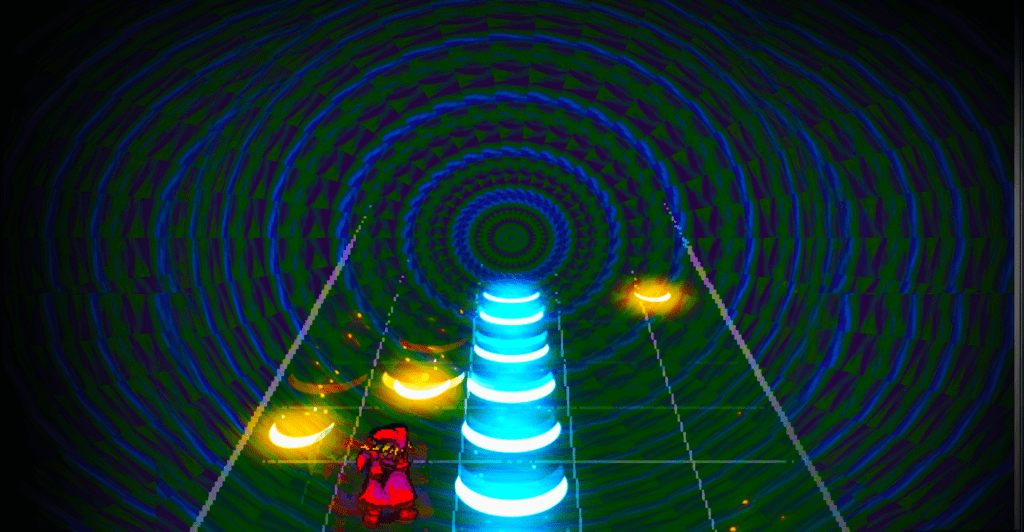
It seems inherently unfair to evaluate the pixel-based visuals of indie games like Everhood against the hyper-realistic graphics of AAA games. It’s like trashing a kindergartner for not painting as good as Rembrandt or Picasso.
That said, just because a game’s graphics are pixelated doesn’t mean they’re bad. And while I readily concede that the pixel trend is becoming tired and played out, there’s still enough life in it for inventive designers to create genuinely beautiful pixel graphics that don’t feel old or gimmicky.
So, is this the case with Everhood?
…Sometimes.
Less Is Less…
Everhood’s graphics definitely do not shine in the overworld, where they are sparse and simple. Characters and objects are primary- and neon-colored, all set against a dark background. It’s around this point that comparisons to Undertale start popping up. Both games look very similar, to the point one could accuse Everhood of ripping off Undertale’s graphics wholesale instead of merely taking inspiration from them.
However, even if this is true (and for the record, I don’t think it is), Everhood’s choice of setting a few pixels against an empty void is artistically valid, and it serves the game well. Visual similarities to Undertale are, for all intents and purposes, irrelevant here.
Why? Because the “Undertale look” fits and sets Everhood’s mood and tone perfectly. Just in case you haven’t been paying attention, I’ll reiterate: this is a weird game!
You’re dropped in the middle of a bizarre, otherworldly dimension with practically no prior understanding or context. And you likely still won’t fully grasp this place even after you reach the ending. This unfamiliar world with all of its strangeness is more than a bit unsettling, and this dissonant undercurrent lurks in the background with the endless, black void. Oh, and that’s before the story takes a very dark turn.
Setting the mood and tone early on in any story is essential. So the devs made the perfect visual choice for Everhood by placing minimalist, pixelated sprites atop a black, empty background. Who cares if the graphics look like Undertale’s? Everhood’s graphical sparseness conveys the sensation of being adrift on a strange land surrounded by an endless void—a feeling of isolation, unease, and more than a tinge of melancholy. And that, in and of itself, justifies Everhood’s chosen aesthetic.
Even if it does feel a bit… sparse. I mean, I get that it’s thematically appropriate, but I wouldn’t have minded a slightly more crowded overworld.
…More Is More
But enough about the overworld. Let’s move on to where Everhood’s graphics are incontestably excellent: musical battles!
Just as each “fight” has its own unique song, it also has its own visuals, which (like the music) reflect the character’s mood and personality, along with the current setting. Psychedelic imagery features in a good chunk of these battles: kaleidoscopic fractals, undulating shapes eddying in and out of existence, scattering neon beams, light trails, object trails, distorted perspectives, strobes, exploding stars… you get the picture.
These blend seamlessly with more character-specific visuals: walls of fire rising behind an enraged beast, or vines and daisies blooming around a flower merchant. Most awesomely, in some battles the world itself seems to shift, warp, and glitch.
These effects are as stunning and visually captivating as they sound. But they serve a greater purpose than just twirling around the background looking pretty—some of these visual distortions also affect the gameplay.
Your movement area gets stretched, squeezed, warped, rotated, sheared, wrapped, and glitched out to infinity and back again. This, naturally, tends to make battles more challenging. You’ll need to quickly adjust to your surroundings’ new shapes, then do so again when they return to normal, to successfully see the battle through.
Some of the more devious effects can be pretty frustrating, such as one that flips the screen upside-down while also reversing your controls. That said, these added hurdles never feel unfair, and they add some nice variety and challenge to the already super-fun combat sequences. They also make finally “winning” a fight feel so much more satisfying.
Oh, and in case this wasn’t apparent, the visuals are trippy as all get-out. People half-jokingly describe Everhood as “Acid Trip: The Game.” I won’t comment on that assertion. But I will say this: if you want to open your third eye but don’t want to break the law or spend decades at a Tibetan monastery, you could do worse than Everhood.
Audio: The Game’s Heart(beats Per Minute)
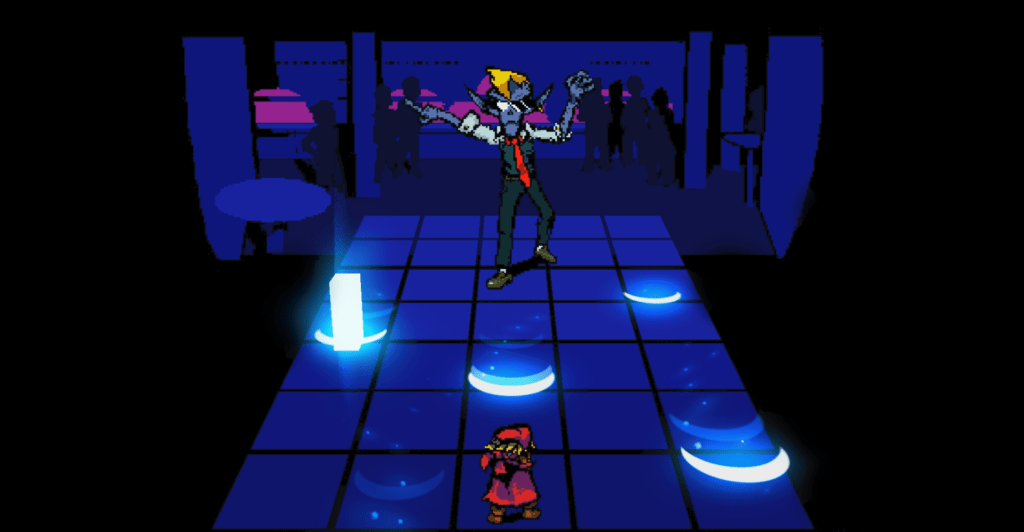
Ah, yes. Audio. In a friggin rhythm game, for crying out loud. The music had better be good! Otherwise, what’s the point? In this genre, the music quite literally makes the game.
So… does it?
Yes. Yes, it does. The music is outstanding, and it alone makes the game worth checking out.
Everhood is a game that leans hard into psychedelic imagery and themes (to put it lightly). So it should be no surprise that electronic dance music (EDM) of all stripes dominates the game’s OST—from deep, pulsating psytrance to frenetically distorted guitar riffs over pounding tribal drums.
So if loud, fast music gives you a headache, or if you’re a curmudgeon who considers EDM to be little more than noise, then this game is not for you. (Maybe go chase those kids off your lawn instead?)
Now, the OST isn’t exclusively EDM. Some tracks feature hippy bongos, jazzy saxophones, and others are metal AF. But it is mostly EDM.
The music also matches the visuals and gameplay. Being a rhythm game, this is expected. But the degree to which they sync up is really quite impressive. Characters, for instance, will time their attacks almost perfectly in sync with the music. How the character moves, how the background changes, how many notes appear, how quickly they move, and the notes’ shapes, colors, and movement all change in perfect time with the music.
For instance, a soothing and ethereal trance synth will accompany a few blue notes on the highway, spaced far enough for you to take a quick breather before the beat picks up again. Fire and flames recur quite often, and tend to appear alongside enraged or more outwardly antagonistic opponents. The flames come complete with an accompaniment of loud, furious, and insanely frantic guitar riffs, as well as a relentless flurry of orange and red notes, tearing through each lane at ludicrously intense speeds.
Everhood’s music spans almost the entire gamut of emotions and moods that music is so good at invoking. There are happy tunes, sad tunes, angry tunes, scared tunes, foreboding tunes, epic tunes, meditative tunes… and they’re all used to great effect.
Even if rhythm games aren’t usually your thing, this is a collection of tunes you simply cannot pass up—particularly if you’re an EDM fan. Fortunately, the entire +2 hour-long OST is available to purchase on Steam, either separately or bundled with the game. If you’re playing on PC, do yourself a favor and get the bundle. These songs will get stuck in your head, and you’ll want to add them to your playlists even after finishing the game.
Story: A Digital Koan
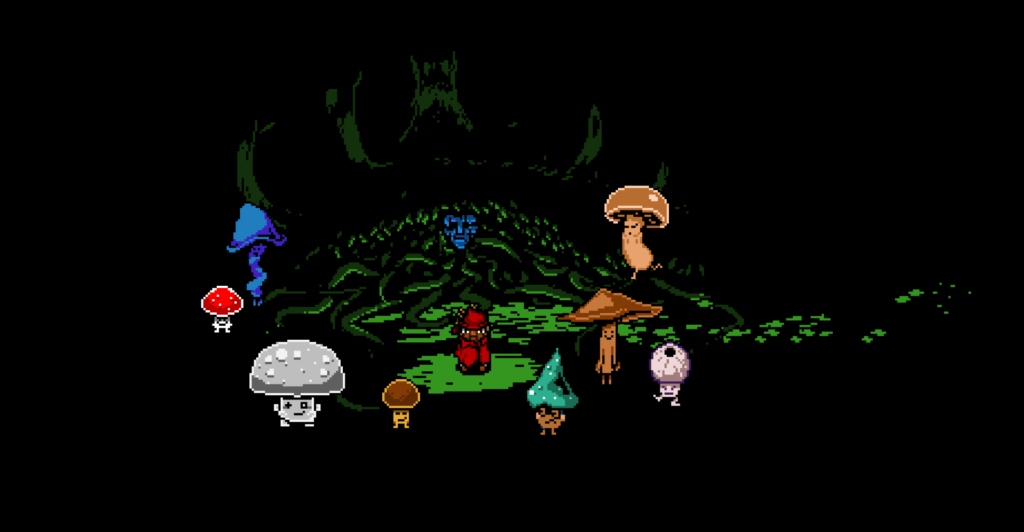
Disclaimer: Everhood’s story is incredibly difficult to discuss in any meaningful detail without venturing into major spoiler territory. So this part of the review will, by necessity, sound vague and wafty compared to the other sections. Apologies in advance.
Anyway, Everhood’s opening premise is simple: you play as a Geno pallette swap called “Red” as they try to retrieve their stolen arm from a greedy pig.
Obviously, there’s much, much, MUCH more to the story than that. But that’s is about as much as I can reveal without spoiling it. And believe me, this is a story you don’t want to spoil for yourself.
What Is The Sound of One Note Clapping?
As you might expect from a game as topsy-turvy as Everhood, its story and lore are vague, complex, elusive, and wide-open to interpretation. Or interpretations. Check out some of the fan theories out there once you’ve finished the game. They’re pretty wild—but since the story itself is wild, the theories don’t sound nearly as implausible as they usually do.
In Everhood, much is revealed, but little is explained, and almost all of it is confusing as hell. Particularly after your first playthrough, when you’re likely to leave with more questions than answers. The truth behind it all may well never be fully revealed or universally agreed on by fans.
This, of course, is precisely the point—the game is quite clear on that. It was practically designed for theorists and lore junkies to discuss on Reddit and Discord until the end of time.
Those who are uncomfortable with ambiguity may not share such enthusiasm. However, the ending does a surprisingly good job of closing the main narrative arc in a way that actually provides a decent amount of closure—even though it leaves a lot unexplained. It that sounds inherently paradoxical, congratulations! You’re starting to get it.
Fact is, Everhood proudly flaunts its ambiguous and contradictory nature every chance it gets. There’s something poetically Zen about this, especially considering “truth” (particularly “absolute truth”) is one of the game’s central themes. It’s almost like a digital koan—which is actually an excellent metaphor for the game and its story. Both Everhood and a Zen koan are meditations on reality’s most enduring and intractable mysteries.
Everhood is a game that deals heavily in the abstract. It deals in the inutterable yet everlasting truths that permeate the very fabric of reality. The philosophical, the ethereal, the everlasting, the transcendental, the spiritual, the sacred, the incredible, the undescribable, the paradoxical. The existential riddles that keep philosophers and theologians employed and awake at night. Precisely what it says in the title: the inexpressible divine moments of truth.
These themes aren’t new—indeed, they’re quite timeless, having been around since we first became a sapient species and could finally start thinking about these things. But boy, is Everhood an inventive and fun way to explore them.
Inspiration or Imitation?
Before we stray too far into the infinite, I do want to discuss Everhood‘s main thematic and narrative influences. The TVTropes summary I quoted in the intro calls out four particular titles, two of which I want to highlight: Yume Nikki and Undertale.
The visual and mechanical allusions to both these games are clear, as we’ve discussed. So unsurprisingly, the similarities in Everhood‘s storytelling and thematic delivery are just as obvious.
Yume Nikki, for instance, invokes the feeling of wandering alone in a surreal and sometimes frightening dream world. Everhood isn’t a literal dream world (or IS it…?), but it’s a similarly strange realm where seemingly anything is possible, and things aren’t always what they seem. Oh, and Uboa makes an appearance. Or something that looks like it, anyway.
That said, Everhood, even in its darkest moments (which can be VERY dark indeed), isn’t nearly as grim, bleak, or hopeless as Yume Nikki. I’d even argue that Everhood’s “bad” endings are happier than Yume Nikki’s only ending. Though I concede this is very much open to interpretation.
Then there’s Undertale.
If the graphics haven’t already tipped you off, Everhood owes a massive debt of inspiration to Undertale in almost every aspect. In fact, if one’s feeling less than charitable, one could call Everhood an Undertale clone, with only the rhythm battles setting it apart (and even those are reminiscent of Undertale’s signature, tough-as-nails, bullet-hell attack sequences).
Now, this isn’t even remotely fair to Everhood, not least because you could easily level the same charge against Undertale for being too similar to the MOTHER series. The fact that “MOTHER-like” is practically its own subgenre at this point—of which both Everhood and Undertale are a part—discredits such assertions.
Nevertheless, I understand where the accusation comes from. Everhood is a direct spiritual descendant of Undertale and does little to hide this fact. The extent of Undertale’s influence on Everhood is obvious and everywhere. But nowhere is this on clearer display than in Everhood’s adoption of Undertale’s most central component, the very thing that makes Undertale… well, Undertale: its morality system.
Again, it’s hard to talk about this in even minor detail without spoiling either game, so I’ll simply say this: yes, Everhood’s “morality system” is reminiscent of Undertale’s.
BUT…!!!
Everhood puts such a unique spin on said morality system—turning it on its head, just like everything else that enters this strange realm—that it feels entirely like Everhood’s own. It works as an homage to and critique of what inspired it, making such a bold statement on the nature of such explorations of morality that it really does stand on its own. That’s why I feel comfortable mentioning it in this review.
So if you enjoyed Undertale and were moved by its story, you’ll likely also enjoy Everhood and its story. Similarly, if you enjoyed Yume Nikki—whether for its surrealism, atmosphere, or its unflinchingly dark and raw tale, then you’ll also find plenty to love about Everhood.
In either case, you’ll be able to appreciate the game’s influences while also enjoying the new things Everhood brings to the fray. If you can, try to look at Everhood for what it is, and evaluate it on its own merits—not in comparison to the games that came before it.
Even Infinity Follows Story Structure
Speaking of the game’s own merits, how does it handle the fundamentals of storytelling? What is there to say about the game’s writing, plot, pacing, and characters? Well, in these areas, Everhood’s delivery is fairly mixed.
The plot, at its core, is actually pretty simple—but the lore surrounding it (which is essential for understanding why you’re doing things or making certain choices) is layered, nuanced, and much harder to wrap your mind around.
On top of that, very few aspects of the game’s lore are outright stated, confirmed, or clearly implied—unless you’re a very thorough explorer. Whether this is a selling point or a dealbreaker comes down to how well you tolerate narrative ambiguity.
The degree to which Everhood is guarded about showing its cards, however, does have advantages. Not knowing much (or at all) adds intrigue and mystery to the story, especially when a tidbit or nugget of info hints at something larger or more sinister at work. Your curiosity, now fully stoked, provides a good impetus for soldiering on, in the hopes of eventually learning enough to make sense of it all.
On the other hand, not having all, most, or even any of the answers for as long as this game withholds them can backfire. So much searching unearthing such few answers can feel vexing, even futile. And a player in the throes of futility is a player about to quit the game.
What I’m saying is, while I love a good open-ended story, perhaps Everhood is a bit too stingy about revealing its secrets.
Simple Characters Aren’t Always Simplistic
About the characters: they’re believable, they’re good, and there’s too little of them.
Everhood is a relatively short game, and you’re basically thrown into the action knowing nothing of its world, the characters, or what’s at stake. As such, you spend relatively little time with each character, limiting opportunities for character development.
There is one big exception to this, a character who’s the closest thing to an additional party member you’ll get in this game—which gives them ample time to grow on you. But otherwise, your time with most NPCs is brief.
Yet despite their limited screen time, they’re well-rounded enough that you could describe each of them without mentioning their appearance or role in the story, and they’d still sound like real people you could run into on the street. Each character has its own distinct personality and its own quirks, wants, and fears. As more lore is revealed, you also come to understand their backstories and motivations. Most are sympathetic, and some are even quite endearing.
The flip side of this is that the limited time you spend with this motley crew makes you wish you had more time to get to know them better. It almost feels like those fleeting moments bonding with them were a tease.
I’ll touch on a particularly egregious example of this. One character, revealed late in the game, is simultaneously the most pivotal to the story and the one you learn the least about. You’ll all but need to complete multiple playthroughs to fully grasp this character’s place in the narrative. And even then, there’s much that’s never revealed about them.
But then again, that’s just business as usual in Everhood. It’s exactly what one would expect from this game.
Pacing Through the End of Time
Everhood’s pacing—ironic, as it’s a literally timeless setting—moves along reasonably well. It does follow your standard three-act story structure, and the shifts in mood, conflict, and goals that kick in at the mid-point feel adequately timed.
The latter half, however, can feel a lot like backtracking. You revisit the same places, fight the same people, in mostly the same way, until you can finally trigger the endgame gauntlet, and the pace picks up again. As I mentioned, this isn’t too painful because the music’s so damn good. And the tonal shift makes the familiar feel somewhat new again. I didn’t mind it too much.
But this will irritate some people. If you hated how Skyward Sword recycled locations throughout its story, then the way Everhood does it will also annoy you.
Finally, while the climactic battles are challenging, fun, and both visually and aurally spectacular, the ending itself drags on too much. Was that the final battle? Did I beat the game? It seems so—nope! Have another one! And another one. There, now you can finally enjoy the ending. Oh, but once that’s done, here: have one more battle, for good measure!
It’s not that the battles aren’t fun! But after a certain point, you start thinking “Geez, I get it. Ok, maybe I don’t. But when are the credits going to roll?” It’s like The Return of the King’s infamouslyendless ending, though thankfully on a much smaller scale.
That said, the ending itself—or rather, the “normal” ending out of a possible five endings—is oh so satisfying. It feels fitting and purifying, and it’s the perfect payoff for soldiering through the abject bleakness that immediately precedes it. It gives you closure (despite all your still-unanswered questions) while simultaneously enticing you to return for more (New Game+, anyone?).
This Game May Invoke Feelings
Now, we come to the writing. One of Undertale’s biggest strengths is its witty, humorous writing (just as the MOTHER series that inspired it), so any “Undertale-like” or “MOTHER-like” game is going to be judged, at least partially, on how well its writing holds up. And Everhood’s writing certainly does.
Like any MOTHER-like worthy of the moniker, an eternity’s worth of humorous quips, quirky characters, and wacky scenarios abound in Everhood, particularly during the game’s comparatively lighter first half. And while every MOTHER-like title delights in the meta and toys with the fourth wall, Everhood’s developers seem to particularly relish playing jokes on the player, combining the game’s inherently chaotic setting with its established propensity for interface screws to very humorous effect.
If you’re a lore nut or a completionist, beware! These meta pranks guard some key bits of lore and easter eggs. Enduring them is easier if you don’t mind having your time wasted, or if you can admire the devs’ inventive—if a tad depraved—sense of humor.
Similarly, Everhood also features a momentous, mid/late-game tonal shift from lighthearted quirkiness to intense pathos. Fans expect such sudden and dramatic twists in their MOTHER/Undertale-inspired stories just as much as they do witty dialogue. This is the MOTHER-like’s other major hallmark, and Everhood’s take on it is just as jarring and memorable as those of its peers in the subgenre.
Again, I can’t get too specific without spoiling the whole thing. But I can promise you this: Everhood‘s story will hit you in the feels. Hard. If you’re highly empathic, emotional, or prone to existential crises, you may want to steel yourself for the rollercoaster to come. But if you can stick through the whole thing, hang on and carry on—you’ll be glad you did! You might even feel like part of your mind or personality has slightly shifted for the better.
Fun Factor: So, Is It Fun? Or Just Strange?
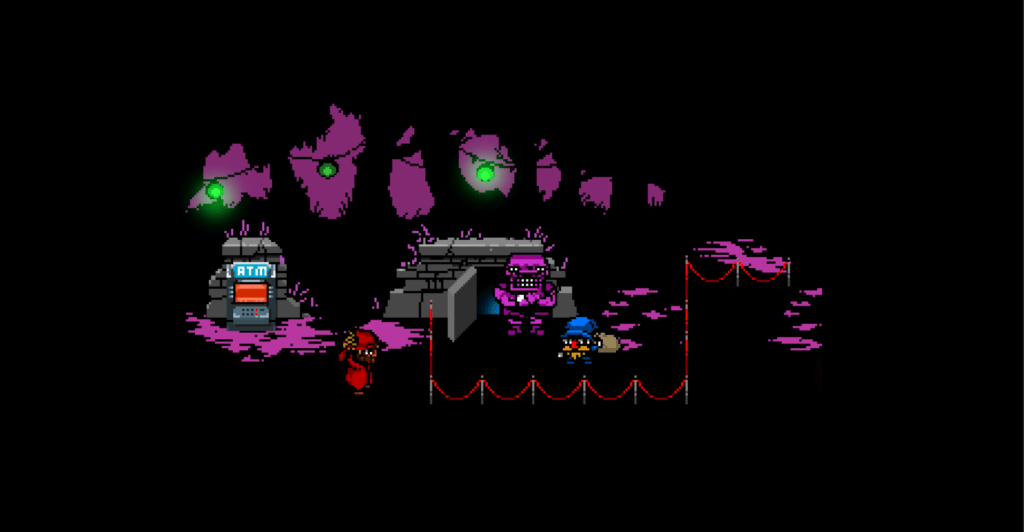
So far, we’ve established that Everhood’s gameplay is unique, the visuals are trippy, the audio is phenomenal, and the story is profound. But we’ve yet to answer the most critical question of all: is this game actually FUN?
And the quick answer is “yes,” with a big caveat: the degree to which you’ll enjoy the game depends on a few factors.
Bro, Do You Even Rhythm?
The first, obviously, is how much you enjoy rhythm games. Because Everhood is, first and foremost, a rhythm game. If you love or even just enjoy rhythm games, then Everhood is a no-brainer.
That said, don’t sleep on this game if this genre isn’t your first choice, or you’re entirely new to it. Chances are, you’ll still find Everhood delightful. The game’s visuals, sound, story, and themes alone are enough to make the game worth playing.
But even ignoring everything else, the devs included some handy anti-frustration features that ensure you’ll have fun, even if you’re not confident in your musicality. Among them: the game makes adjusting the difficulty level very easy, you can retry battles as many times as you’d like, and some of the more prolonged battles even have checkpoints.
As such, I can confidently recommend Everhood if you’re at all intrigued by the game’s music, visuals, or novelty—even if you’re lukewarm on rhythm games. You’ll still have plenty of fun—and who knows, you might even emerge with a new appreciation for the genre. I certainly have!
However, if you actively dislike rhythm games, don’t have at least a rudimentary sense of rhythm, or haven’t played an action game since the SNES era, then you probably won’t like Everhood. The rhythm battles are too central to the gameplay to be ignored or compartmentalized. And even after progressing just a bit, it becomes surprisingly easy to lose even on the most accessible difficulty levels. Regrettably, not even the most slapping OST or trippiest visuals in the world can make up for being constantly reminded that your hands aren’t as dextrous as they were in the 90s.
Big Galaxy Brains, Welcome!
Another important consideration: how “brainy” do you like your games? Because this isn’t a game you unwind with after work or before bed. And this isn’t a game where you check your brain at the door and zone out. It’s intense, it’s complex, it’s obtuse. Everhood will wind you up, and it will make you think, so if the last thing you want to do after work is think more, then either pass on the game or save it for the weekends.
Conversely, if you like games that explore weighty, complex, or difficult topics (and what could be heavier than pondering existence itself?)—think Metal Gear, Bioshock, This War of Mine, or The Last of Us—or if you enjoy heavily abstract titles like Kentucky Route Zero, then Everhood will give you plenty to think about.
Fan theorists in particular will have a field day.
Everything is Weird. Nothing is Weird.
Finally, the last question to ask yourself: how “weird” do you like your games? If you’ve read this far and still haven’t gotten the message, let me say it loud and clear: this game is bizarre!!!
Everhood exists on its own little plane, playing by its own little rules, and you are merely a guest in it. Everything is possible, but nothing is guaranteed. You’ll feel like you’re following along one moment, then hopelessly confused the next. Don’t expect an explanation or a reason for what made that character so skittish, or why those flowers smell like paper. Everhood has as many possible interpretations as people who’ve played it, all of which are valid.
So if you tolerate uncertainty, thrive with constant change, think abstractly and in terms of possibilities, or feel that you see the world differently from others, then Everhood is right up your alley. Similarly, if you are heavily introspective, gravitate towards altered states of consciousness, or have ever described yourself as a “psychonaut,” Everhood will feel like you’re coming home.
On the flip side, if you like your entertainment clean, orderly, and neatly wrapped up at the end, chances are you will have dropped the game by the third battle.
This game is different, which in gaming can be very hit-or-miss. Fortunately, Everhood’s unique blend of rhythm mechanics, RPG-like exploration, philosophical treatises, and incisive deconstructions of Undertale-like morality systems… works!
So, to summarize: Everhood is a lot of fun if you enjoy rhythm games, EDM, crazy visuals, deep thoughts, or just plain “weird” stuff.
Everhood’s Severest Shortcoming
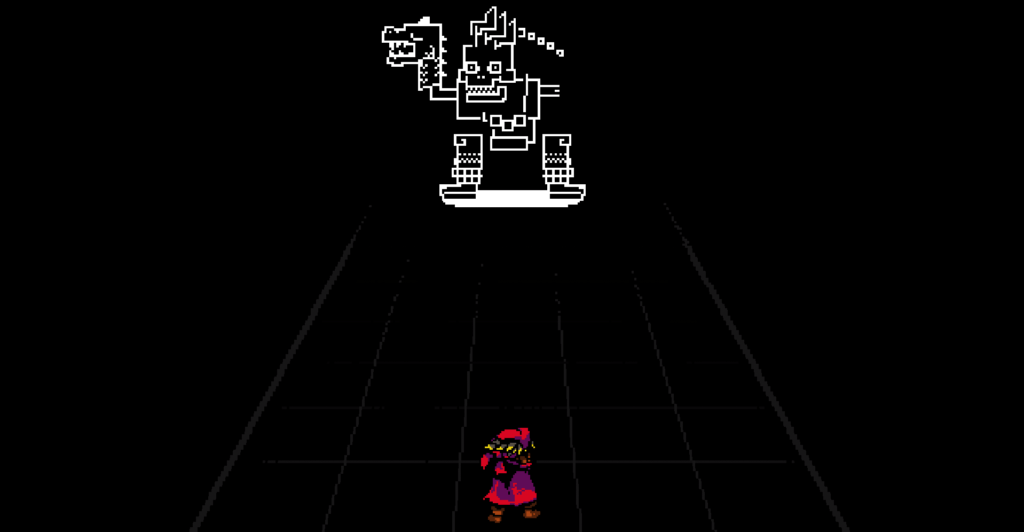
Alas, nothing created by humans is perfect. And however great this game is, I’d be remiss not to mention its single biggest flaw—and a nearly fatal one, at that: its unacceptably long loading times.
Every time you enter a room, leave a room, start a battle, end a battle, progress to a different stage in a battle, lose a battle, respawn, trigger a cutscene, finish a cutscene, or load a save, you’ll be staring at a blank screen for at least five seconds. In the worst cases, this can even rise to 20 seconds or more.
While I can (somewhat) understand this for some of the more visually elaborate rhythm sequences, it’s far less excusable when passing from one tiny, sparsely pixelated room to another tiny, sparsely pixelated room. Especially considering far more graphically intensive games like Breath of the Wild have far shorter loading times.
And while waiting ten seconds to respawn after dying is annoying enough, I’m somewhat willing to tolerate it for the game’s music, visuals, and story. But during the endgame, which jumps from one frenetic combat sequence to another, then another, and then yet another, each shift comes with its own half-minute-long blank loading screen. And that’s in addition to all the loading screens you get before respawning—which, this being a final “boss,” you’ll see a lot of.
This is not acceptable. It absolutely kills the pacing and momentum during the precise moment in the story when both need to be firing on all cylinders. It ends up almost ruining an ending that otherwise feels immensely satisfactory and cathartic. That the finale doesn’t pay off nearly as much as it could, all because of a trivial gameplay (or rather, non-gameplay) flaw, is a big stain on the game and my overall enjoyment of it.
That said, I’m reviewing this on the Switch, so it may just be an optimization issue, one that will hopefully be fixed with an upcoming patch. But as it stands now, the loading times are long enough to significantly hamper the experience, to the point of frequently taking the player out of the moment. That’s not only one of storytelling and gaming’s cardinal sins; it’s also, as the hippies would say, “a total bummer, man.”
Back to Our Mortal Plane
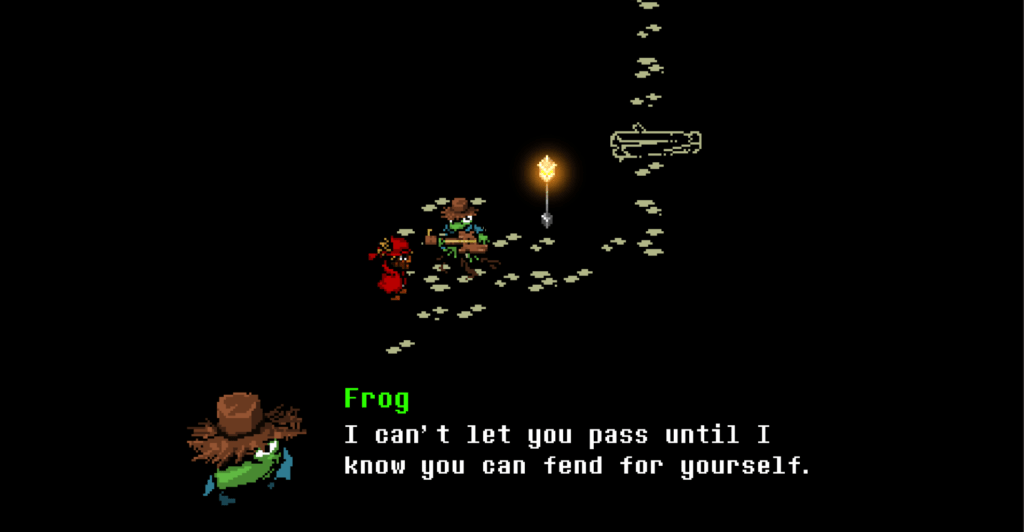
Nevertheless, while the loading times remain a significant strike against Everhood, the fact remains:
Everhood is a jaw-dropping, mind-bending, audiovisual spectacle like nothing else in gaming, easily a top contender for Best Indie Title of 2021, and a perfect reminder of everything indie devs contribute to gaming and why we should support them however we can.
Why this criminally underrated game slipped past seemingly everyone’s radar in back in March (mine included… and on my birthday, no less!), I cannot say. But with streamers increasingly paying attention to Everhood, and VGM virtuosos like GaMetal covering its tracks, hopefully this sapphire in the void will finally get the exposure and recognition it deserves.
If you are an EDM junkie, enjoy topics like philosophy and cosmology, or have ever described yourself as a “psychonaut,” you will feel right at home here. On the other hand, if you can’t hold a beat, get freaked out by the nature of infinity, are disturbed by reminders of your own mortality, or prefer more concrete and defined narratives, you may want to look elsewhere. Only you can decide for yourself.
If you’re up for one hell of a ride, then boot up Everhood, buckle up, keep your hands inside the vehicle at all times, and enjoy the trip.
(Oh, and wear headphones!)
This review covers the game’s Nintendo Switch version. This game was reviewed using the author’s own purchased copy.
[penci_review]

